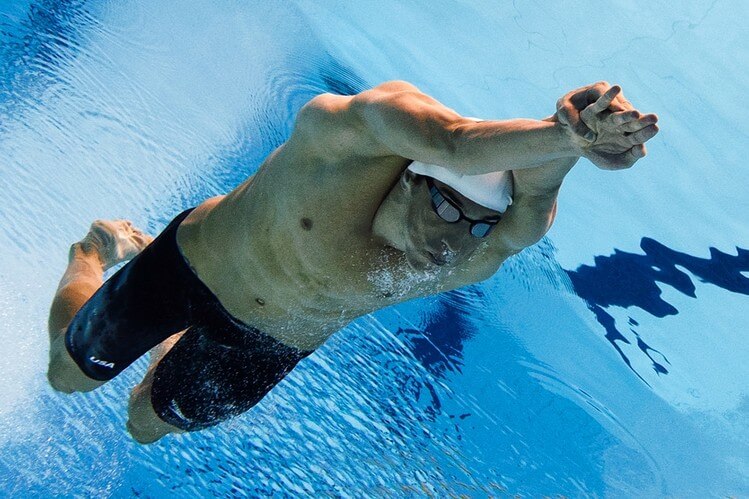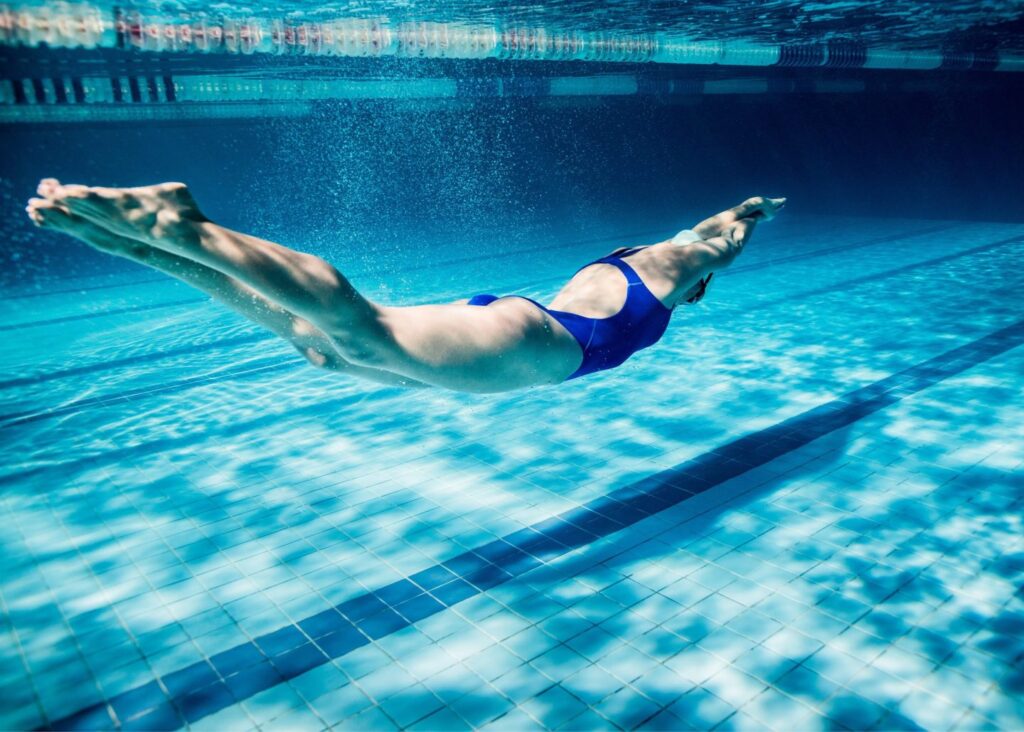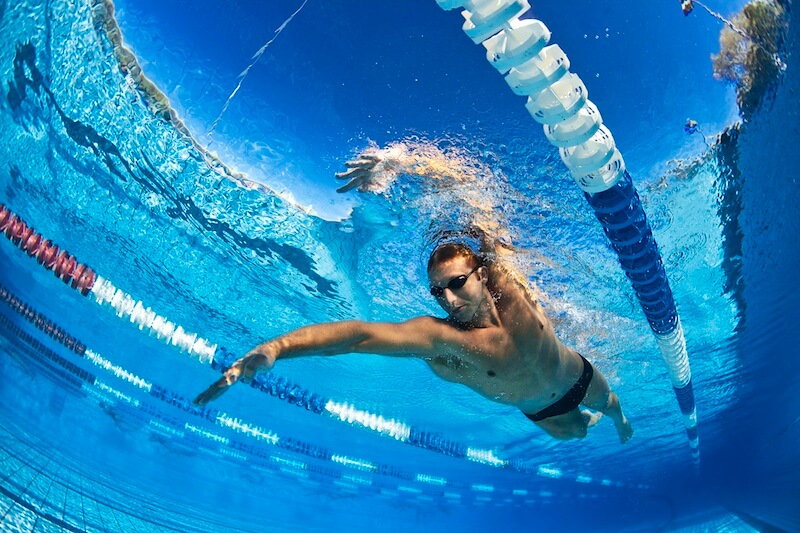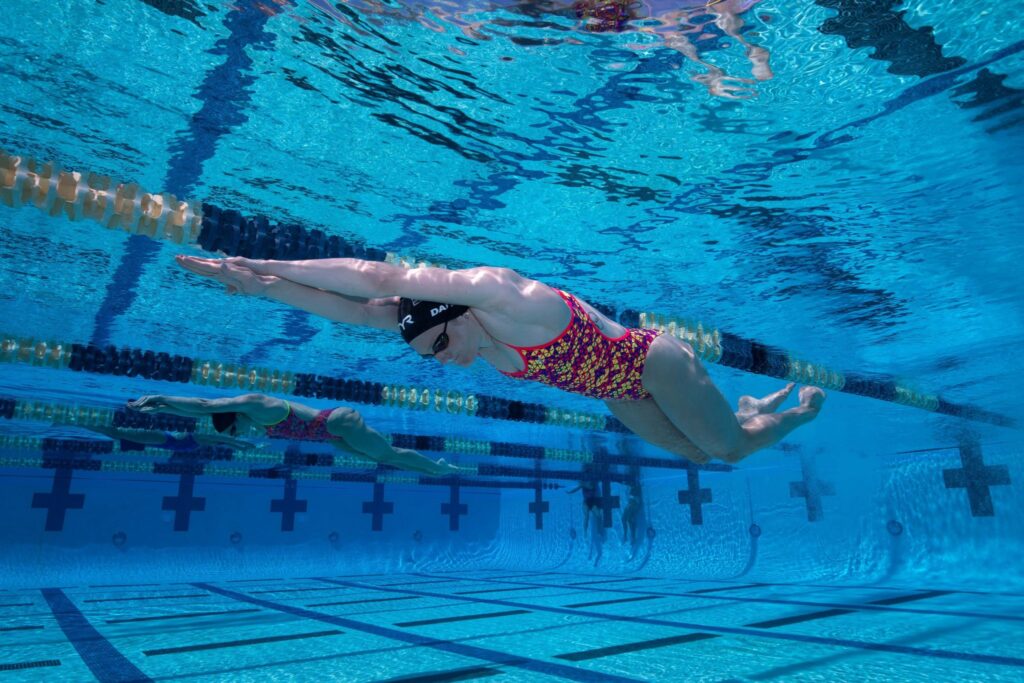Diving into the world of competitive swimming demands not just discipline but also strategic training. To edge out the competition, it’s crucial to enhance your freestyle kick. This article provides a deep dive into the top freestyle kick drills designed to boost your speed in the water. We’ll explore a variety of drills that target strength, technique, endurance, and power, ensuring a comprehensive approach to improving your swim. Whether you’re a novice or an experienced swimmer, these drills will help you kick your way to success.
Key Takeaways
- Mastering the right kick technique can significantly transform your freestyle performance.
- Alternating between different drills can enhance rotation and timing, which are critical for efficient swimming.
- Incorporating fins and underwater dolphin kicks into your sets can add power and speed to your kick.
- Focused narrow kick drills and resistance training are essential for engaging the full muscle chain and increasing propulsion.
- Mixing up your swim workouts with various drills and cross-training activities keeps training engaging and effective.
Kick Your Way to Success: Essential Drills for a Stronger Freestyle
The Simple Trick to Transform Your Swim Kick
Hey there, water warriors! Ready to give your freestyle a turbo boost? Let’s dive into a simple trick that’s a game-changer for your swim kick. First off, if you’re new to the pool, soak up these freestyle swimming tips for beginners to get started on the right foot… or should we say fin?
Freestyle swimming with a kickboard using a three-pull and breath technique is a great way to improve your freestyle stroke efficiency and breathing rhythm.
Now, let’s break down the freestyle swimming steps into something you can practice next time you hit the water. Remember, the kick in freestyle swimming is not just about moving your legs; it’s about creating a rhythm that works with your entire body. Here’s a quick list to keep in mind:
- Start with a relaxed flutter kick, focusing on keeping your kicks small and consistent.
- As you get comfortable, integrate the kick into your swimming freestyle technique for beginners, ensuring you’re not just splashing but propelling forward.
- Practice how to breathe in freestyle swim by turning your head to the side in sync with your arm strokes, without disrupting the kick rhythm.

By honing these basics, you’ll be slicing through the water like a hot knife through butter. And hey, don’t forget to mix it up with some drills to keep things interesting!
Alternating Drills for Enhanced Rotation and Timing
Diving into freestyle drills for beginners can be a game-changer for those new to the sport. Start with alternating single-arm strokes, focusing on the rotation of your torso with each stroke. This not only improves your timing but also teaches you how to engage your core for better propulsion.
To really nail the timing, try counting your strokes. Aim for a consistent number per lap, which will help you maintain a rhythm and prevent overexertion.
Here’s a simple set to incorporate into your routine:
- 4 x 50m single-arm freestyle (25m right arm, 25m left arm)
- Rest for 30 seconds between each 50m
- Focus on smooth transitions between arms
Remember, freestyle for beginners is all about patience and practice. Don’t rush the process; instead, enjoy the journey of improving your swim one stroke at a time.
Using Fins for Power: Fast 25s with Underwater Dolphin Kicks
When it comes to freestyle kick drills, nothing ramps up the intensity like strapping on a pair of fins and blasting through some fast 25s. The Arena Powerfins Pro Swim Fins are a top choice for swimmers aiming to strengthen their kick. By incorporating underwater dolphin kicks into your sets, you’re not only working on power but also on the fluidity and rhythm that are essential for a sleek freestyle.
For a killer set, try alternating between underwater dolphin kicks and full-speed freestyle on the evens. This drill is perfect for those looking to refine their drills for breathing in freestyle, as the added speed and resistance force you to focus on efficient breath control.
Remember Michael Phelps’ freestyle? His incredible propulsion came from a well-tuned kick. To emulate that, work on drills that challenge your legs in different ways. Here’s a simple set to get you started:
- 4 Rounds
- Swim 3 x 200 IM – Descend 1-3 to FAST
- Swim 4 x 75 Stroke with tempo trainer – ALL FAST
- Kick/Swim 8 x 25 with fins odds: underwater dolphin kick FAST, evens: Stroke FAST
- Kick/Swim 100 easy backstroke – alternate kick/swim by 25
This set not only builds power but also hones in on your kick’s timing and coordination, crucial for that final push to the wall.
Fine-Tune Your Technique: Stroke-Specific Workouts
Stroke and Roll: Mastering the Art of Rotation
Getting your rotation right is a game-changer in freestyle swimming. Effective rotation is about how much rotation and when it occurs. We’ll dive into the nuances of both, starting with the stroke and roll drill. This exaggerated movement teaches you to roll for air instead of lifting your head, which is a common mistake that can slow you down.
With stroke and roll, you’ll experience a full rotation to the back, allowing for a smoother breath. The goal is to replicate this movement in your regular freestyle, but with less intensity.
Now, let’s talk about combining drills. By alternating between stroke and roll and underwater recovery, you’re not just working on the rotation itself but also on the timing of your breath. It’s like hitting two birds with one stone, and here’s how you can do it:
- Perform underwater recovery and, when you breathe, roll over to the back.
- Mix this drill with regular freestyle to find the sweet spot in your rotation.
- Practice these drills in succession to really improve your breathing technique.
Remember, the key is to integrate these drills into your regular swimming routine. Check out these swim drills and swimming advice to help improve your swimming further.
Underwater Recovery: When to Rotate for Optimal Performance
Mastering the timing of your rotation during underwater recovery is crucial for a seamless freestyle. It assists in rotating your body side to side, enhancing the smoothness and effectiveness of your stroke. This precise timing ensures your head, arms, and body are all synchronized, reducing the effort needed for each breath.
By focusing on the timing of your rotation, you can achieve a more efficient and less strenuous swim.
Alternating between stroke and roll and underwater recovery drills can significantly improve your breathing technique. These drills complement each other, with stroke and roll emphasizing the degree of rotation and underwater recovery focusing on the timing. For a comprehensive workout, try combining these drills to refine both aspects simultaneously.

Here’s a simple drill sequence to practice:
- Perform underwater recovery.
- As you breathe, roll onto your back as in the stroke and roll drill.
- Alternate with regular freestyle to integrate the improved rotation into your swim.
This drill not only helps with the rotation but also allows you to take a breath without moving your head, mimicking the natural breathing movement in freestyle.
Mixing It Up: Combining Drills for Comprehensive Improvement
Stagnation is the enemy of progress, especially when it comes to swimming. To avoid hitting a plateau, it’s crucial to mix up your workouts with a variety of drills. This not only challenges different muscle groups but also keeps your mind engaged.
By incorporating a mix of sprints, kickboard kicks, and stroke-specific exercises, you can create a dynamic and effective swim session.
Here’s a simple workout structure to get you started:
- Warm-up: Start with easy laps to loosen up.
- Sprints: Go all out for one lap, pushing your limits.
- Kickboard Kicks: Grab a kickboard and focus on your kick technique.
- Stroke Variation: Switch between different strokes to work all muscle groups.
- Cool Down: Finish with gentle laps to relax your muscles.
Remember, the key to improvement is consistency and variety. Keep your sessions fresh and challenging, and you’ll see the benefits in your speed and endurance.
Endurance and Power: High-Octane Sets for Stamina
Short Reps, Big Gains: Building Endurance with Intense Intervals
Intense intervals are the bread and butter of building endurance and speed in the pool. By focusing on short, high-intensity bursts, you can significantly improve your aerobic capacity. Start with shorter distances and gradually increase as your stamina builds. Here’s a simple set to get you going:
- 8 x 50m at high intensity, with 20 seconds rest
- 6 x 75m, pushing your limits, with 30 seconds rest
- 4 x 100m, maintaining a strong pace, with 40 seconds rest
This progression helps you manage your energy and ensures that you’re pushing hard throughout the entire workout. Remember to focus on maintaining a consistent stroke rate and strong kick.
Consistency is key. Aim to incorporate these intense interval sets into your routine at least twice a week to see noticeable improvements in your endurance and overall swim speed.
As you become more comfortable with the intensity, mix in some variations to keep your muscles guessing and your mind engaged. Throw in a set of 200s or even some variable pace work to test your limits and track your progress.
The Weekend Challenge: Smooth, Strong, and Speedy Swim Sets
Ready to shake up your weekend routine with a swim set that’s all about speed, strength, and smooth swimming? Coach Sara McLarty has crafted a workout that’s perfect for triathletes looking to hone their performance. Sprint sets are a great way to boost your speed and confidence in the water. This workout is designed to push your limits and help you master the three keys of a solid triathlon swim: sprint, smooth, and strong.
Dive into the challenge with a mix of sprints, kicks, and dives. Each segment of the workout is tailored to refine different aspects of your swim, from explosive power off the blocks to maintaining a strong, steady pace throughout.
Here’s a quick rundown of what to expect:
- Start with a warm-up focusing on form and technique.
- Move into a series of short, high-intensity sprints to get your heart racing.
- Follow up with kick drills to build leg strength and endurance.
- Finish with longer, smooth swims to practice pace control and energy conservation.
Remember, the goal is to leave the pool feeling like you’ve conquered a significant challenge. So, grab your goggles, and let’s make this weekend’s swim session one to remember!
Race-Day Prep: Top Age-Groupers Share Their Secrets
As the countdown to race day begins, top age-groupers are fine-tuning their routines to ensure they’re in peak condition. It’s not just about the hours of training; it’s about the quality of each session. Each athlete has their own secret sauce, a blend of workouts that gets them to the start line feeling confident and ready.

For instance, a pre-race tune-up swim is highly recommended 2-3 days before the event. This session is designed to sharpen your senses and get your muscles firing without overtaxing them. Similarly, incorporating short, high-intensity bike reps can boost your power without causing fatigue.
The key is to strike a balance between maintaining fitness and ensuring you’re rested enough to unleash your full potential on race day.
Here’s a snapshot of what some of the fastest long-course age-groupers are doing as part of their race-day prep:
- Swim: No walls, no lanes, no rest sets to mimic open water conditions.
- Bike: Power-up reps and hill sprints to build strength and adapt to course profiles.
- Run: Track sessions with pace changes to enhance speed and cadence control.
Narrow Your Kick: Tools and Techniques for Focused Power
Engaging the Full Muscle Chain with Narrow Kick Drills
To truly engage the full muscle chain, it’s crucial to incorporate drills that challenge swimmers to maintain a narrow kick. This not only improves power but also ensures that the entire muscle group is activated during the kick phase. Here’s how you can start to make this happen in your routine:
- Begin with a Kick Band or 1FlexBand to guide your legs into the correct position.
- Progress to using Neo Bands for stronger swimmers, limiting knee separation to just a few inches.
- Introduce Power Bags on the calves, and for advanced swimmers, place them on the feet to increase resistance.
By consistently practicing with these tools, you’ll develop a kick that’s not only powerful but also efficient, propelling you through the water with minimal drag.
Remember, the goal is to ‘hide’ your legs and feet behind your bottom, reducing drag and maximizing the kick’s effectiveness. Start with Power Bags on the calves and work your way up to the feet as your strength and technique improve.
Advanced Tools: From Kick Bands to Power Bags
When it comes to refining your kick and building leg strength, advanced tools like Kick Bands and Power Bags can be game-changers. These tools are designed to target the muscle chains essential for a powerful and efficient kick. Starting with a Kick Band or a 1FlexBand can help you maintain a narrow kick, which is crucial for developing power. As you progress, incorporating Neo Bands can further restrict knee separation, honing your technique even more.
For those who are ready to take their training up a notch, Power Bags offer an additional level of resistance. Placing Power Bags on the calves challenges intermediate swimmers, while advanced athletes might place them on the feet during breaststroke kicks and drills. This progression ensures that swimmers at all levels can continuously improve their power and technique.
Embrace the challenge of these advanced tools and feel the difference in your kick’s strength and efficiency.
Here’s a quick rundown of some other essential swim training gear that can complement your use of Kick Bands and Power Bags:
- Swim goggles
- Swim fins
- Swim snorkel
- Swim parachute
- DragSox
- Ankle band
- Tempo Trainer
Remember, the key is to integrate these tools into your regular training routine to see significant improvements in your kick and overall performance.
Read more: Transform Your Stroke: Top Swim Drills for Freestyle Mastery
Resistance Training: Parachutes and Power Chutes for Muscle Engagement
Looking to amp up your swim training? Resistance training with swim parachutes and power chutes is a game-changer for those serious about boosting their performance in the water. These tools are not just about adding drag; they’re about enhancing your muscle engagement and building the strength that translates into speed.

Here’s the deal: by incorporating resistance tools like the FINIS Swim Parachute into your routine, you’re not only working against the water but also against a consistent force that challenges your muscles at every stroke. This means you’re getting a double whammy of resistance, which is proven to build muscle and increase power.
The key is to use these tools in a way that complements your swim training, ensuring that you’re engaging your full muscle chain and not just going through the motions.
Remember, it’s not just about strapping on the gear and hoping for the best. It’s about strategic use and understanding how to engage your muscles effectively. Here’s a quick rundown of some popular resistance training tools:
- Regular Parachute: Adds moderate resistance, perfect for all levels.
- Power Chute: Offers more resistance for advanced swimmers.
- Power Bags: Can be worn on feet or hands for targeted resistance.
- Long Cords: Allow for super-fast stroke rates with added resistance.
By integrating these tools into your swim workouts, you’re setting the stage for some serious muscle engagement and, ultimately, faster swim times.
Mix It Up: Creative Workouts to Keep Your Swims Fresh
Fun Mix: Adding Variety to Your Swim Sessions
Spicing up your swim routine isn’t just about staving off boredom—it’s about challenging your body in new ways to build confidence and skill. Incorporating a ‘Fun Mix’ into your sessions can be a game-changer, offering a refreshing break from the monotony of lap after lap. Think of it as a smorgasbord for your swim workouts, where each drill or set serves as a unique flavor to savor.
By weaving in different strokes, speeds, and techniques, you’re not only keeping things interesting but also working different muscle groups and honing various aspects of your swim technique.
Here’s a quick rundown of a ‘Fun Mix’ session you might want to try:
- Start with a warm-up of choice strokes to get the blood flowing.
- Mix in some sprints, kicks, and dives to ramp up the intensity.
- Throw in a few ‘Flashes of Fast’ to sharpen your speed.
- Cool down with a slower, technique-focused drill like ‘Drill Slow, Swim Fast’.
Remember, the key is to stay engaged and enjoy the process. As you experiment with different combinations, you’ll likely discover what works best for you and, more importantly, what keeps you coming back for more.
Read more: Making a Splash: An Introduction to Freestyle Swimming for Newbies
Stroke Mix: Diversifying Your Swim Routine
Shake things up in the pool with a stroke mix that challenges different muscle groups and keeps your workouts from becoming monotonous. By incorporating a variety of strokes into your routine, you’ll not only prevent boredom but also promote balanced muscle development and improve overall swimming technique.
Here’s a quick mix to get you started:
- 4 x 100m freestyle, focus on even strokes
- 3 x 100m backstroke, concentrate on arm rotation
- 2 x 100m breaststroke, work on timing and glide
- 1 x 100m butterfly, maintain rhythm and breath control
Embrace the challenge of switching between strokes. It can be a refreshing mental break and a great way to enhance your swim fitness.
Remember, the key to a successful stroke mix is to maintain proper form throughout each stroke. This ensures you’re getting the most out of your workout and not ingraining bad habits. So, dive in and enjoy the variety!
Sweet Spot Bike Intervals: Cross-Training for Swimmers
Cross-training with sweet spot bike intervals can be a game-changer for swimmers looking to enhance their performance. These intervals are designed to hit that ‘sweet spot’ intensity where you’re working hard enough to make significant gains, but not so hard that you can’t sustain the effort or recover effectively.
Incorporating bike workouts into your routine can lead to improved cardiovascular fitness and muscular endurance, both of which are crucial for swimming. Here’s a simple structure to get you started:
- Warm up with 10 minutes of easy cycling
- Perform 4-6 intervals of 5 minutes at sweet spot intensity, with 5 minutes of easy pedaling in between
- Cool down with 10 minutes of easy cycling
By focusing on consistent, structured bike training, you’ll build endurance that translates into more powerful and sustained swim strokes.
Remember, the key is to maintain a steady, challenging pace that feels like a 7-8 out of 10 in terms of effort. This type of training can help you push through those tough sets in the pool and keep your swim workouts fresh and exciting.
Are you looking to spice up your swimming routine? Dive into our treasure trove of creative workouts at Swim Time Log and discover innovative techniques to keep your swims fresh and exciting. From mastering the butterfly stroke to exploring open water challenges, we have everything you need to elevate your aquatic experience. Don’t let your swim sessions become mundane—visit our website now for a splash of inspiration and join a community that celebrates the joy of swimming!
Wrap-Up: Kick Your Way to Swimming Success
Alright, water warriors, that’s a wrap on our deep dive into freestyle kick drills! Remember, the key to making waves in your swim game is consistency and variety. Mix up these drills to keep your muscles guessing and your motivation sky-high. Whether you’re adding some tempo with the FINIS Trainer, narrowing your kick with the Kick Band, or powering through with the Power Bags, each drill is a step towards a stronger, more efficient kick. Don’t forget to have fun with it and flip fast! Now, go make a splash and show that pool who’s boss!
Read more: 5 Fundamental Freestyle Techniques Every Beginner Swimmer Should Master
AUTHOR
Sang Nguyen
Sang Nguyen is a former national swimmer for Vietnam who has transitioned into coaching. With a passion for fostering a healthy swimming community and connecting like-minded individuals,......Read More
BLOG
Maybe You Are Interested
Good Swim Meet Snacks: What to Eat for Optimal Performance
Good nutrition is crucial for swimmers to maintain energy, recover quickly, and perform at their...
Read More...Optimizing Your Performance: The Best Diet for Swimming Training
Optimizing your performance in swimming is not just about rigorous training; it’s equally crucial to...
Read More...Achieve Peak Performance with This Diet Chart for Swimmers
Whether you’re a novice or an expert swimmer, understanding the right diet is crucial for...
Read More...Eating Like a Champion: Exploring the Diet of Michael Phelps
Michael Phelps, renowned for his Olympic triumphs, has a diet as extraordinary as his swimming...
Read More...Muscle Gain for Swimmers: Tailoring Your Diet for Strength
Swimming is a demanding sport that requires a tailored approach to nutrition to support muscle...
Read More...A Comprehensive Diet Plan To Gain Weight For Swimmers
Swimming is a demanding sport that requires meticulous attention to nutritional needs to optimize performance,...
Read More...